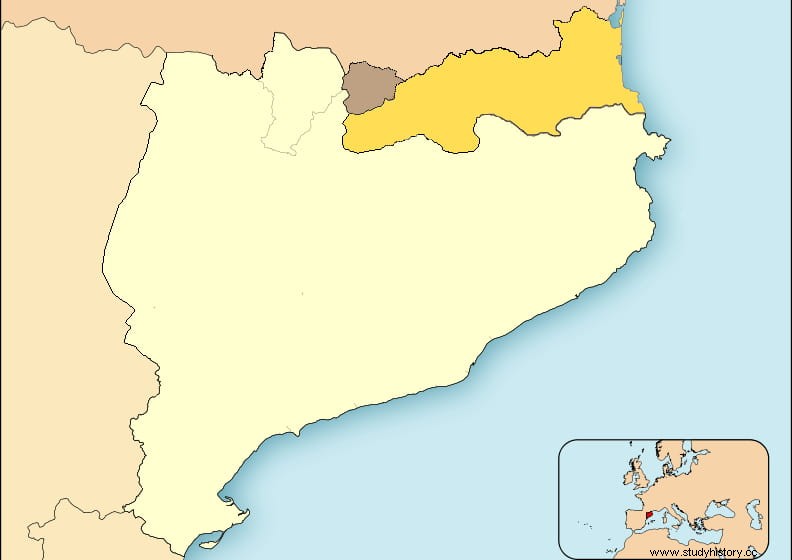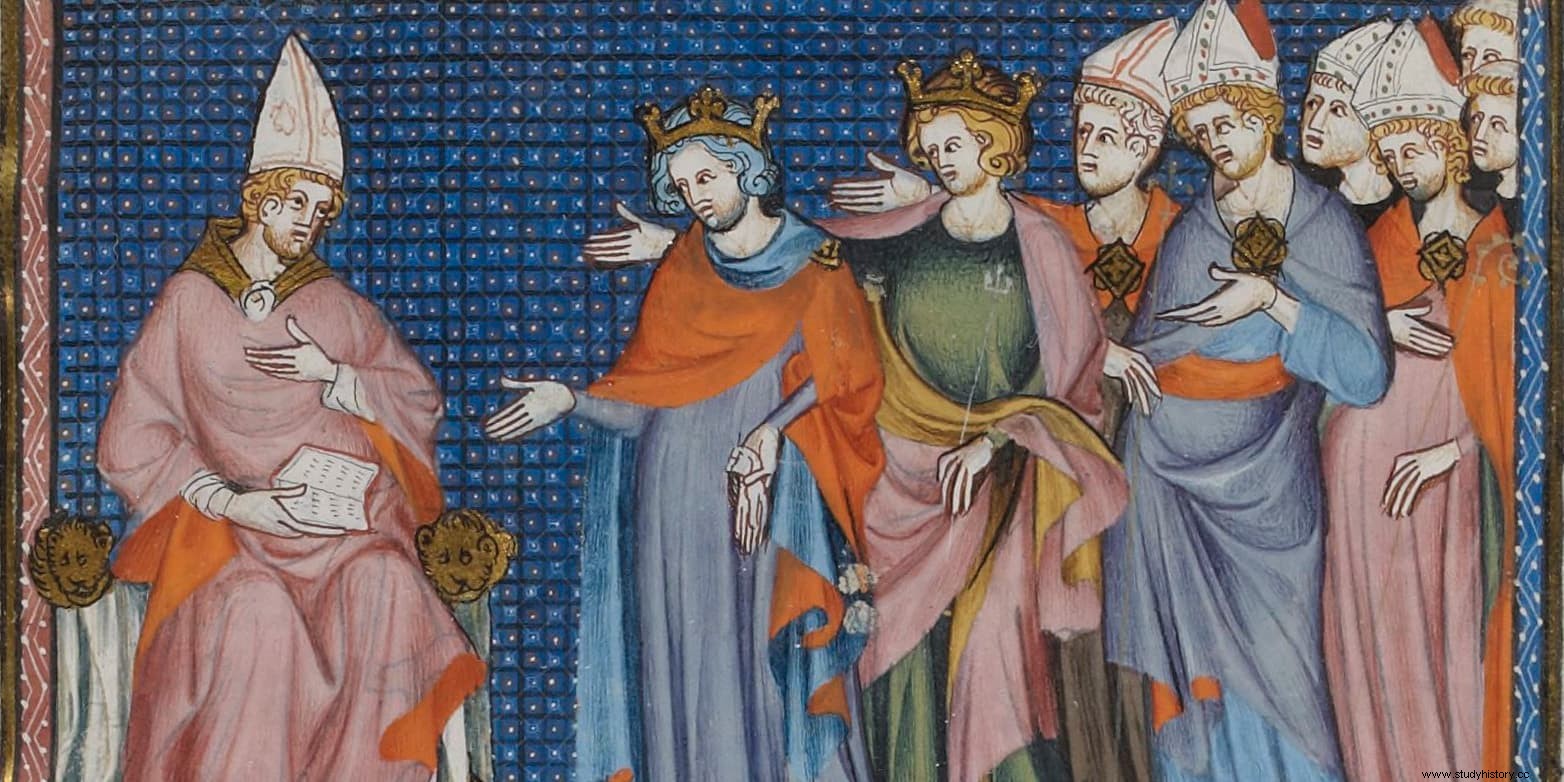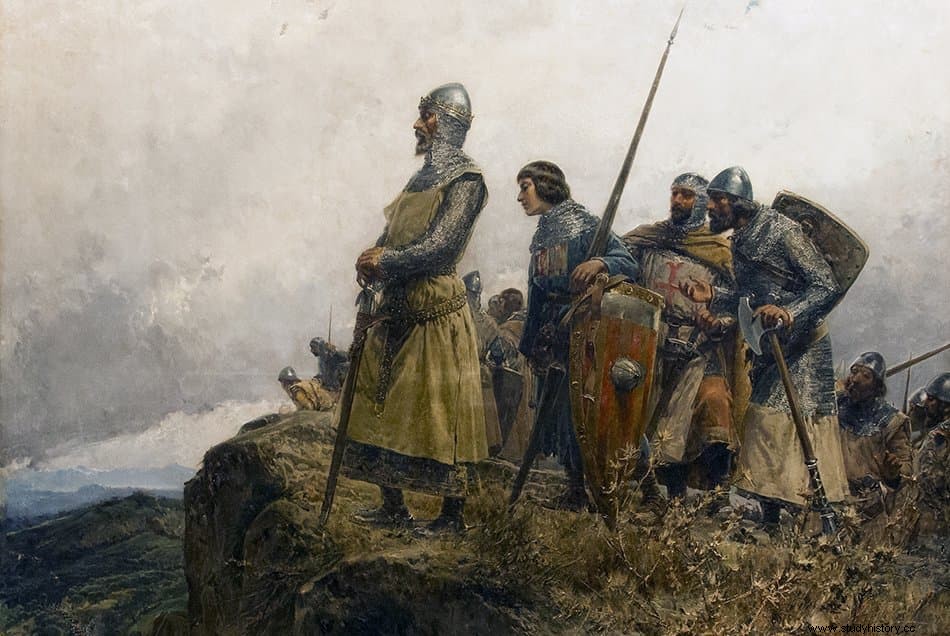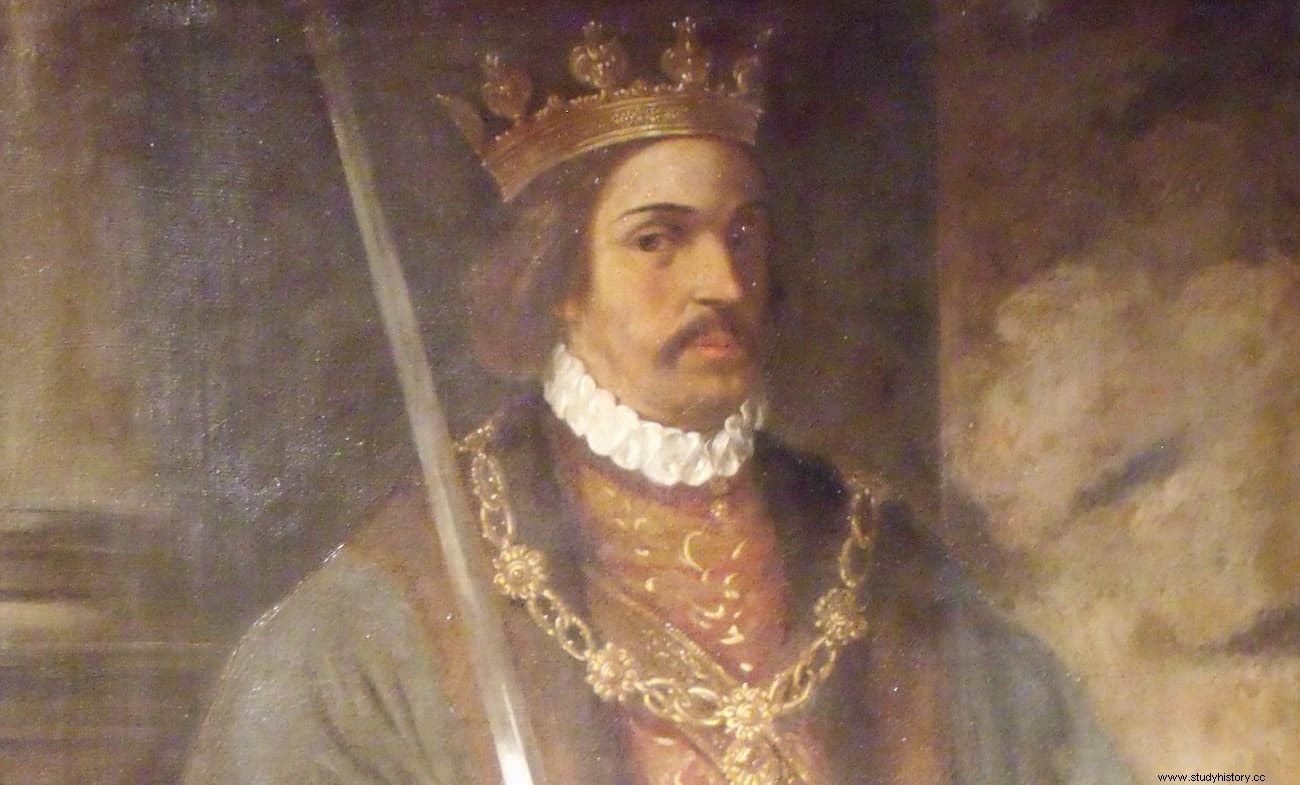Surely the reader remembers that article that we dedicated to the Challenge of Bordeaux, framed in the context of the wars that the French Carlos de Anjou and the Aragonese Pedro III maintained for the throne of the Kingdom of Sicily, which finally remained in Aragonese hands. But the rivalry continued and was not resolved until 1285, when a fleet commanded by Roger de Lauria defeated the Franco-Genoese fleet that supported a land invasion of Catalonia. It was in the Battle of Formigues, which not only put an end to that campaign but also allowed the Kingdom of Mallorca to be seized.
Actually, the invasion was not ordered by Charles of Anjou, who had enough to defend the Kingdom of Naples -at the cost of suppressing a revolt-, after the constant defeats he suffered against the aforementioned Roger of Lauria, (he not only lost Sicily but also the islands of Capri and Ischia, plus the mainland towns of Nicotera, Catelvetro and Castroiviceri). His own son, Carlos el Cojo , fell prisoner during a naval confrontation in the Neapolitan gulf on June 4, 1284, and was still a captive when his father died in January 1285, hence he could not succeed him and Roberto II de Antois was appointed regent.
Therefore, the one who decided to invade Catalonia was the French King Philip III the Bold , which had a double objective:on the one hand, to help his cousin Carlos of Anjou by opening a second front that would force the Aragonese to lift the pressure they were exerting in southern Italy; on the other, to seize that county from them and turn it into a kingdom for his third son, Carlos de Valois, who claimed his rights because his mother was Isabel de Aragón. For this he had several allies, who contributed troops, supplies and funds for what had been declared by the pope a crusade against the Crown of Aragon.

The first ally was the Republic of Genoa, wary of the growing power that Aragon was acquiring in the western Mediterranean thanks to the powerful fleet of Roger de Lauria; a real threat to its commercial supremacy. The second was the King of Majorca, Jaime II, second son of Jaime I the Conqueror , who paradoxically was the brother of the Aragonese monarch Pedro III and was unhappy because the Majorcan kingdom that he inherited from his father was much smaller and more modest than the one received by his firstborn.
The third was the Papal States, headed by Pope Martin IV, French by birth and therefore inclined to support the Capetians. In fact, when the Sicilian Vespers took place, a popular rebellion on the island that Pedro III instigated with Byzantine acquiescence and made it pass into his hands, the pontiff excommunicated this monarch and promulgated the aforementioned crusade against him. Other minor allies were the Kingdom of Navarra and the Lordship of Albarracín.
Against them, Pedro III only had Catalan and Valencian troops, since the Aragonese nobility refused to come to his aid. In 1283, the king arrived in Tarazona from his trip to the frustrated Challenge of Bordeaux and the nobles presented him with a memorial of grievances and claims against the crown's attempts to impose their authority on them, at a time when the monarchical power was beginning to overthrow hitherto strong walls of feudalism. The demands made on Pedro III were to preserve his privileges, not pay more taxes and extend the Fueros de Aragón to the Kingdom of Valencia, which was to be annexed.
In the background was discontent over the repression suffered between 1275 and 1280. First, because of the insurrection of a nobility group made up of Aragonese and Catalans who refused to abide by the royal decision to come to the aid of the Crown of Castile against the Benimerines . Second -and related economically-, due to the dire situation of the coffers, exhausted after the war expenses of Jaime the Conqueror , which had forced Pedro III to establish the questias in Aragon and the bovaje (a tax on yoke of oxen that used to be collected when a king was crowned and could be paid in money or personal benefits) in Catalonia.

The claims focused on confirming local privileges, abolishing the bovaje and other taxes that were required to settle in Sicily and Calabria, convening the Catalan Courts annually and respecting the Usatges of Barcelona (a traditional legislative corpus). Several prominent noblemen led by Roger Bernardo II de Foix, who had refused to obey the king, were subdued by force in Balaguer, in the year 1280. Things were tense, then, and appeared serious because the monarch found himself before the threat of forming a league called the Union of Aragon (which would come true in 1287) if the sovereign acted against them. So in 1283, at the Cortes held in Zaragoza, Pedro III granted a General Privilege agreeing to many of the requests.
And so things were when in 1284, while the court was still in Tarazona, Eustaquio de Beaucharnais, governor of the Kingdom of Navarre (disputed by France and Aragon but at that time leaning towards the former), entered Aragonese territory through Sangüesa at the head of a French army. Eustaquio had been one of those outwitted by Pedro III in Bordeaux, so he had a double reason for it. His troops took the castle of Ull and then advanced looting whatever population they found, from Ull itself to Lerda and Filera, also occupying the towns of Bailo, Arbués and Berdún.

In February a truce was agreed, but hostilities did not take long to restart and Eustaquio received the help of Auger de Les to take control of the Aran Valley. Pedro III had to face the Navarrese invasion without counting on the Aragonese nobility, despite which Catalan troops were enough to lay siege to Tudela and force the invader to retreat. But, meanwhile, Charles of Valois, who was fourteen years old, was crowned King of Aragon by Pope Martin IV, which was a good example of the dimensions of that crusade. Because it was launched on the ground in 1285 and its troops were far superior to those of Eustaquio.
In fact, according to sources, around two hundred thousand men gathered in Narbonne, of which half were infantry (seventeen thousand of them crossbowmen) and sixteen thousand cavalry, although the figures are always debatable. They were joined by Jaime II of Mallorca, who, being also Count of Roussillon and Cerdanya, could facilitate the passage through his lands to the Crusader army. And, indeed, it was through there that he entered Catalonia, to find something unexpected:despite the positioning of his lord, the Roussillon population faced the French in some places, such as Salses, Perpignan, Elna and the Collado de las Panizas. His bad behavior prevented him from winning over the local population, as had already happened in Sicily.
This forced the Crusaders to advance slowly to take those places, until they decided to take a detour through the Pyrenees through La Massana, in present-day Andorra. The Catalans withdrew first to Peralada and then to Gerona, led by the infante Alfonso (Pedro III's eldest son), who had quickly organized a squadron of eleven galleys -which he left under the command of admirals Berenguer Mallol and Ramón Marquet- to defend the coastline and prevent the invaders from taking supplies by sea. In that same sense, Roger de Lauria was ordered to come with his fleet from Palermo (Sicily).
However, the French managed to seize Ampurdán, entering Castellón de Ampurias, Figueras, Rosas, San Felíu de Guixols and Blanes, and laying siege to Girona. The king came to the aid of the latter with a thousand and a half men (a thousand infantry and five hundred horsemen), a large part of them Almogávares who went too far ahead and were put to flight by the Gallic knights. This meant that the city surrendered, since its defender, Ramon Folc de Cardona, had promised Roger Bernardo de Foix, a French commander, to do so if he did not receive help in twenty days.

However, all was not well among the French. His squadron was defeated by the Mallol and Maquet galleys at San Felíu de Guixols, thus finding himself in a difficult situation:in enemy territory and with the supply lines he maintained by sea with Narbonne and Aigues-Mortes cut off. Something that worsened on August 24, when Roger de Lauria finally arrived in Barcelona with his forty ships and joined the admirals. Palermo was left defenseless, but it was a risk that had to be taken because in this way the naval numerical inferiority against the adversary was compensated.
The move paid off, as Roger de Lauria's military genius was indisputable. Calabrian by birth and noble by descent, he had settled in Aragon after Charles of Anjou expropriated all his family possessions and assets. There he married Margarita Lanza, an aristocrat related to Emperor Frederick II and Saint Thomas Aquinas, with whom he would have three children. In 1285 he contracted a second marriage with Saurina de Entenza, daughter of Count Berenguer VI, chief of the Almogavars, who gave him six other offspring.
Appointed Admiral of the Crown, Roger de Lauria won one victory after another in Sicily against the Angevin fleet, thanks to tactical innovations that included the use of spurs on the bows of ships -typical of Antiquity- and copious bodies of crossbowmen at board, at a time when naval warfare was basically based on simple boarding. Following this triumphant trend, Roger de Lauria, seconded by Mallol and Marquet, went out again to meet the French ships off the Formigues Islands, an archipelago located off Palamós and made up of four tiny islets (hence the name Formigues =Ants).

There he found the enemy, made up of about forty galleys:between fifteen and twenty were French, led by the Occitan Berenguer Guillem de Lodeva, and another ten or sixteen belonged to the Republic of Genoa, under the command of Enrico de Mari and Giovanni de Orreo. His fighting line was too extended, making his center vulnerable and allowing him to be attacked without any chance of getting help in time from the wings. This is how Roger de Lauria saw it, who decided to try a coup the night of August 28.
To give the impression of having more galleys than he actually had, he ordered each one to light two lanterns aft instead of one, which in the dark of night seemed to double their number. And so, his irruption through the center of the adversary, charging with his rams and launching massive volleys of bolts with his crossbows, so that the rival sailors could not act, was devastating. Fear seized them, thinking that they were facing a larger fleet than it really was, and they lost fifteen to twenty galleys, between those sunk and those captured.
A total disaster from which only Orrea's galleys could escape and which in France could only be explained with the classic resort to treason, pointing the finger at the French admiral, according to the troubadour Joan Esteve de Bezers. But the Aragonese squad was not finished yet. He immediately set sail for Rosas, where fifty more ships were anchored with provisions and supplies for the land army. Roger de Lauria took them by surprise on the night of September 3, when he approached hoisting the Gallic flag, and his victory was complete.

It is said that barely two hundred and sixty Frenchmen survived those battles, who were blinded and returned to their country, guided by another who was only left with one eye for that mission (another fifty remained prisoners for their lineage, for ransom). The chronicler Bernat Desclot recounts that the sad entourage had to deliver an expeditious message to King Philip III the Bold :
The battle of Formigues meant, in practice, the end of the crusade. Without supplies, the invading army was sold out and, on top of that, an epidemic spread among its ranks, decimating it. While Roger de Lauria liberated Barcelona, the French evacuated Girona and began to withdraw from Ampurdán, suffering heavy attacks in Besalú, Le Perthus and Coll de Panissars. Finally the surviving crusaders reached their country because the number of wounded and sick they had was such that they too were allowed to go for mercy.
Now, Pedro III was not willing to let that go unpunished. The first target of his revenge was his brother Jaime II, against whom he sent an expedition that took Mallorca from him. Pedro died in the middle of the campaign, in November of that same year (curiously, Carlos de Anjou, Martín IV and Felipe III had also expired), but his son Alfonso III took over, who the following year added Ibiza (also taking Minorca from the Muslims in 1287). Jaime II only had the non-island territories (Roussillon, Cerdanya and Montpellier) and he did not recover the Balearic Islands until 1295, by the Treaty of Anagni.
Another who had to pay was Juan Núñez de Lara, who had tried to arrest Pedro III on his return from Bordeaux to hand him over to Felipe III. His lordship of Albarracín, which he repopulated with Navarrese, was absorbed by the Crown of Aragon. On the other hand, Languedoc also suffered an invasion in 1286 by two thousand Almogávars landed under the command of Roger de Lauria. Although the French mustered a formidable army to block his way, they were swept away at Beziers.
France managed to keep the Aran Valley, but Carlos de Valois could never reign in Aragon and even escaped being taken prisoner for very little, because in the Coll de Panissars he was allowed to pass, along with his father the king and his family, out of deference to his lineage, while the troops were attacked. In 1295, by the aforementioned Treaty of Anagni, he definitively renounced the throne; ironically, at that time it was occupied by Jaime II, when Alfonso III died without issue.
